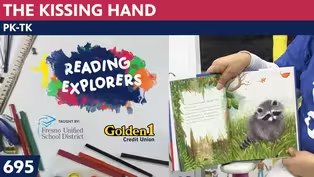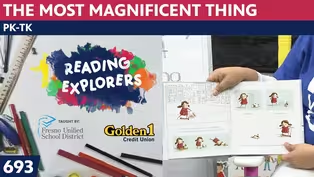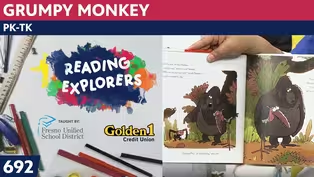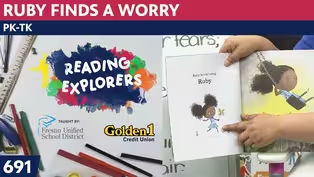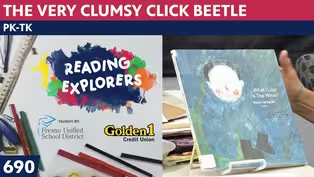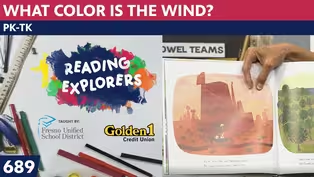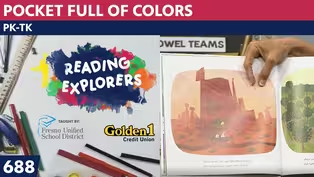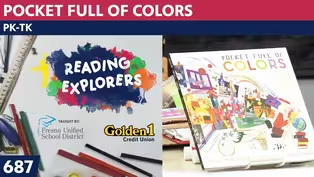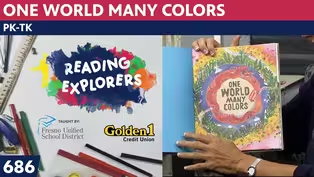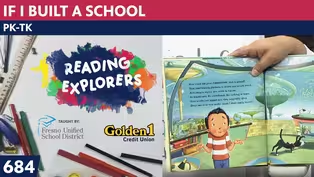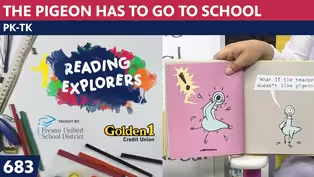
TK-356: Z is for Grevy's Zebra by Andy Warhol
Season 3 Episode 311 | 14m 5sVideo has Closed Captions
Join Mrs. Readwright at Camp Discovery!
Transitional Kindergarten teacher, Mrs. Readwright, welcomes students back to Camp Discovery, a fun learning space packed with reading adventures & fun games!
Problems playing video? | Closed Captioning Feedback
Problems playing video? | Closed Captioning Feedback
Reading Explorers is a local public television program presented by Valley PBS

TK-356: Z is for Grevy's Zebra by Andy Warhol
Season 3 Episode 311 | 14m 5sVideo has Closed Captions
Transitional Kindergarten teacher, Mrs. Readwright, welcomes students back to Camp Discovery, a fun learning space packed with reading adventures & fun games!
Problems playing video? | Closed Captioning Feedback
How to Watch Reading Explorers
Reading Explorers is available to stream on pbs.org and the free PBS App, available on iPhone, Apple TV, Android TV, Android smartphones, Amazon Fire TV, Amazon Fire Tablet, Roku, Samsung Smart TV, and Vizio.
Providing Support for PBS.org
Learn Moreabout PBS online sponsorshipMore from This Collection
Valley PBS and Fresno Unified School District have partnered with Golden 1 Credit Union to create Reading Explorers Lessons for grades Pre-Kindergarten through Third grade. The daily lessons will be taught by Fresno Unified School District teachers and are created to help students practice their reading skills and reinforce lessons during distance learning.
Video has Closed Captions
Valley PBS presents Reading Explorers Lessons for Pre-Kindergarten and TK. (26m 27s)
PK-TK-693-The Most Magnificent Thing
Video has Closed Captions
Valley PBS presents Reading Explorers Lessons for Pre-Kindergarten and TK. (26m 26s)
Video has Closed Captions
Valley PBS presents Reading Explorers Lessons for Pre-Kindergarten and TK. (26m 28s)
Video has Closed Captions
Valley PBS presents Reading Explorers Lessons for Pre-Kindergarten and TK. (26m 28s)
PK-TK-690: The Very Clumsy Click Beetle
Video has Closed Captions
Valley PBS presents Reading Explorers Lessons for Pre-Kindergarten and TK. (26m 22s)
PK-TK-689: What Color is the Wind?
Video has Closed Captions
Valley PBS presents Reading Explorers Lessons for Pre-Kindergarten and TK. (26m 21s)
PK-TK-688: Pocket Full of Colors
Video has Closed Captions
Valley PBS presents Reading Explorers Lessons for Pre-Kindergarten and TK. (25m 58s)
PK-TK-687: Dancing Through Fields of Colors
Video has Closed Captions
Valley PBS presents Reading Explorers Lessons for Pre-Kindergarten and TK. (26m 20s)
PK-TK-686: One World Many Colors
Video has Closed Captions
Valley PBS presents Reading Explorers Lessons for Pre-Kindergarten and TK. (27m 13s)
PK-TK-685: School is Wherever I am
Video has Closed Captions
Valley PBS presents Reading Explorers Lessons for Pre-Kindergarten and TK. (26m 32s)
PK-TK-684: If I Built a School
Video has Closed Captions
Valley PBS presents Reading Explorers Lessons for Pre-Kindergarten and TK. (26m 21s)
PK-TK-683: The Pigeon Has to Go to School
Video has Closed Captions
Valley PBS presents Reading Explorers Lessons for Pre-Kindergarten and TK. (26m 22s)
Providing Support for PBS.org
Learn Moreabout PBS online sponsorship♪ Good morning to a brand new day ♪ ♪ Time to learn and games to play ♪ ♪ Learning things is so much fun ♪ ♪ Learning is good for everyone ♪ (upbeat music) - Hello, early learners.
And welcome back to the art room.
For 26 days, we were going to do the ABCs of art.
And today is the 26th day, but I'm going to couple it with something I'm starting out with the ABCs of art, and then we're gonna do the 123s of art.
But let's start out with our hello song.
♪ Hello, nice to see you, everyone ♪ ♪ Hello, nice to see you, everyone ♪ ♪ Hello to you ♪ ♪ Hello to you ♪ ♪ Hello to you ♪ ♪ Hello to me ♪ ♪ Hello, nice to see you, everyone ♪ All right, since we're still doing the alphabet, I won't need the mystery suitcase, even though it is mystery Monday.
We are going to talk about the ABCs of art, and we're going to bring in the Z, but then the 1, 2, 3, 4, 5 of art.
We've been singing, ♪ A, B, C, D, E, F, art ♪ And we're now going to sing, ♪ 1, 2, 3, 4, 5 of art ♪ ♪ That's the way that we will start ♪ ♪ 1 is for zebra ♪ ♪ 2 is for Pez ♪ ♪ 3 is for pears ♪ ♪ That's what Cezanne says ♪ ♪ 4 is for hearts painted by Jim Dine ♪ ♪ That is art and the number line ♪ And today our artist is Andy Warhol.
And we have talked about Andy Warhol before when he did the Maryland print.
When we talked about the Nutcracker, we did four nutcrackers.
When we did the snowmen, we did four snowman with Andy Warhol.
But the art that we're looking at today is Z is for zebra, our last letter of the alphabet.
And it goes like this, "Warhol painted this zebra, like in our city zoo.
If you can draw a horse, you can draw a zebra too."
Now look at this.
This is one of the series that Andy Warhol was paid by a couple, who said they wanted people to think about animals, and how the animals were endangered.
So they hired Andy Warhol to do a series of 10 animals.
And they were called, this one's the Endangered Species series.
And this one is Grevy's Zebra.
And I thought we could use some pastels to do the outline.
And you can see that he has done stripes of yellow and white, and of course, a zebra who is black and white striped anyway.
He said he dressed these up in fancy colors.
He made them so bright and it went right along with all of his work where he uses bold colors.
And we know that, because we've done several pieces of art using bold colors.
So I brought white paper, but if you have a blue paper and you want it to look more like Andy's, you can do that.
So we're going to talk about, we're going to do, just like with people, we talked about how people, if from their waist up, it's called the bust of the person.
This is like the bust of the zebra.
It's from its shoulders up.
I'm going to do mine sideways.
You can do yours however, you'd like.
If you want the zebra to look at you, or if you want it to look off to the side.
So this is Grevy's Zebra 300, and it was painted in 1983.
So I wonder if it really did make people think about the animals that were endangered.
And you know about endangered animals, there are so few of them left because they've maybe been hunted by other animals or by humans.
And so we need to be careful about endangered animals, because we don't want to take away their habitat where they live and work and play.
So let's get our things ready.
I am going to use my white paper, and I also wanted to show you how I prepare my paper.
And since it's kind of almost a square, I tried to make it almost that same size, but I wanted you to see what I do with my permanent pen.
I use a ruler or a straight edge, and I put it near the edge of my paper.
And I make it as even as I can, even though this straight edge is very bumpy because I think I've used it with my x-acto knives.
But I'm going to do the outline, because I think this makes it look like it's in a frame.
And I think it makes it look more finished.
So if you ever wanna do this, I end up oftentimes doing it at home, after I take all the art home and finish it, which I wanted to remind you to look behind me at the art we did last week.
Let me put this right here, and there I'm ready.
Do you see how I made it all connected together in a frame around the outside?
And let me put my lid back on my pen and make sure it snaps shut.
I'll show you behind me real quick.
Oh, I think I won't.
I'll show you afterwards.
Let's look at this.
Now.
I told you in the rhyme that if you can draw a horse, you can draw a zebra.
And I'm gonna bring the zebra down, so that we can look at it while we work.
Oh, I clipped it up here with a pretty strong clip.
And here it is.
So I have to think about that his ears are going to go here.
His face will go down here, and neck and shoulders.
And then, what's different from a zebra and a horse, a horse has a mane that goes down on its back and has a little piece of hair that comes between his two ears.
But the zebra's mane stands straight up.
So when we go to draw him, you're going to want to make his mane stand up.
So let me get started.
I know a pencil is easier to use, but you can't see it when I draw with it.
So I'm going to think about his face is about as big as my hand.
Then his ears are above, his back goes here, and his neck and shoulders go here.
And I'm not very good at drawing horses, but I'm going to give this a try.
So if you would like to get your paper and do his forehead with a little lump where his eye would go.
I'm going right here, and that way.
I'm going to go down and his nostril will go there.
Here's where his mouth is and go up.
And it has kind of a jaw line there.
I wonder if it's looks like anything else you know.
This ear is on the other side of his head, so I'm putting that there.
I'm putting his other ear facing forward here.
I'm going to make sure that his mane, I'm going to do this so that you can see that it's going to stand up and go down the back.
This is his jaw.
I'm going to do it below that a little bit, and go down for his neck and go down for his shoulder.
Now, I'm thinking I'm really ready.
I think I will put little dotted lines where I'm going to put the inside of his ear.
Here's where his eye is.
Think about right where that bump was where I stopped.
That's where I'm gonna do his eye.
And it's a curved line, a little curve there, and a curved line under.
Now, all the stripes are going to go back at an angle like this, and some go down around his mouth.
We have to remember his nostril is pretty big.
I think these animals that do a lot of running need a big nostril, because they are running and getting so fast and run out of their air.
So they need to breathe through that big nostril.
His mouth is here.
I like mine to be kind of smiley.
I'm using my black pen to do the kinds of stripes, but I can paint them in.
I will do some stripes like this.
I'll do some stripes down to his nose.
I'm just drawing them in like this, because I might go back around them with yellow.
I really haven't decided yet.
And some stripes go down to his jaw.
Are you drawing yours?
Are you coloring with a pencil?
Are you doing this with crayons?
Or are you doing this with a pen too?
I'm going to draw it's stand up mane.
This part, the stripes are even thicker, and they're all going up toward his mane.
If you don't want to do your stripes this way, you know what a zebra looks like.
And if you don't, be sure to look in books, because they'll show you how to draw him.
This is really a stylized one, which means it isn't exactly realistic.
It is just showing what it could look like, because we're not trying to do this like a science project, where you would make it look exactly like a real zebra.
Now I want to put some more stripes here and I can add more later, because my permanent pen allows me to get in there.
And oh, I put a polka dot on my finger for our girl, Yayoi Kusama.
I'm going to use some of my pastels, and I'll use the white and I'm going to go around the outside of my stripes a little.
Because what I'm going to do is as I paint over this, his was red, and black, and white, and yellow, and I'm going to add those colors just around each stripe.
So that when I paint, wherever the pastel is, the paint will not stick.
So I'm just going around all these places.
I'm just going around, outlining, and putting in some of these stripes, so that I can put my red paint on, and I can paint in with black if I want, still going next to it in between these black main stripes.
Boys and girls, I know I tell you this all the time so that you don't get nervous about not finishing, I don't think I'll be able to finish this, but I will bring it back and let you see what I've done.
Now you can see where he even outlined the front with yellow.
I'd like to kind of do some of the things he did.
I'm putting some stripes next to these.
I think I'll do my black with my black pen inside his eye, so you can see where his eye really is blackened in.
Oh, it's like my special letter here.
I can see the letter C in here, because my first name is Claudia.
So that is my special letter in there.
Let me drag over my paints, where my red paint is.
I can use my special paint brush that has water in it, and see how it works out.
I have a little dish of water here.
If you decide you're just going to do yours with crayons or colored pencils, just continue doing yours.
I'm going to paint over mine and make a lot of in between here, wherever the pastel is not, it will go over this.
And I can go in here, 'cause wherever I drew with my white pastel, the red paint will not go.
See, I've tried to paint over it.
It won't.
It says, "Oh no, you put pastel here, Miss Readwright, go around it."
So I am.
I'm making by zebra red.
Will yours be red?
Maybe you'll do it blue.
Let me tell you about tomorrow.
Tomorrow, we're going to do the number 2.
And number 2 is for an artist, whose name is Jean-Michel Basquiat.
And he made a painting of like a Tyrannosaurus rex.
And we're going to need white paper, black paper, a pencil, a glue stick, scissors, your coloring tools.
You'll need maybe some, I'm gonna use my oil pastels, so just bring all of your coloring tools.
And let's get ready to sing our goodbye song, while I'm going to keep painting.
♪ Goodbye, see you next time, everyone ♪ ♪ Goodbye, see you next time, everyone ♪ ♪ Goodbye to you ♪ ♪ Goodbye to you ♪ ♪ Goodbye to you ♪ ♪ Goodbye to me ♪ ♪ Goodbye, see you next time, everyone ♪ Boys and girls, thank you for joining me today.
And we did the number 1 and the zebra.
I'll see you tomorrow.
Bye-bye, now.
(upbeat music) ♪ Good morning to a brand new day ♪ ♪ Time to learn and games to play ♪ ♪ Learning things is so much fun ♪ ♪ Learning is good for everyone ♪ (upbeat music)
Support for PBS provided by:
Reading Explorers is a local public television program presented by Valley PBS
